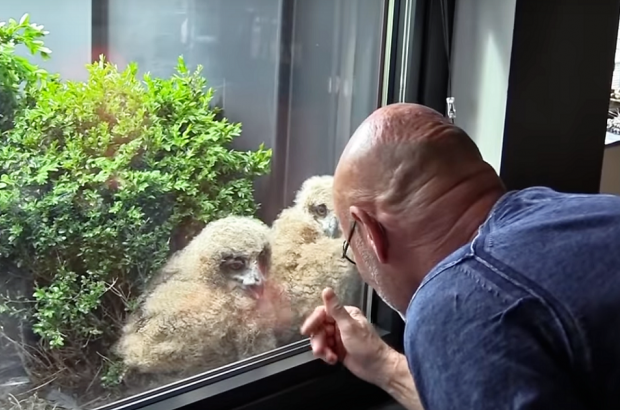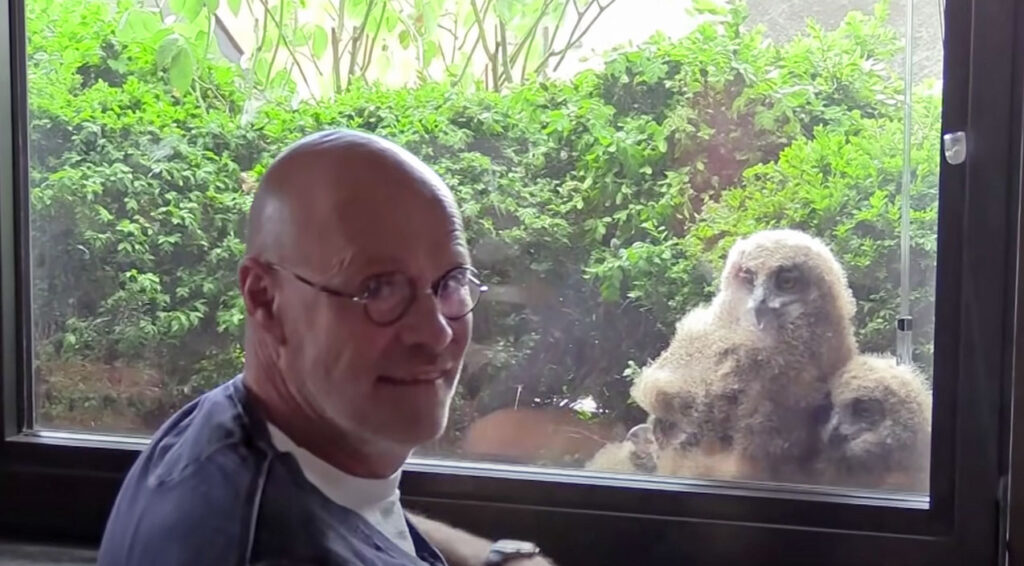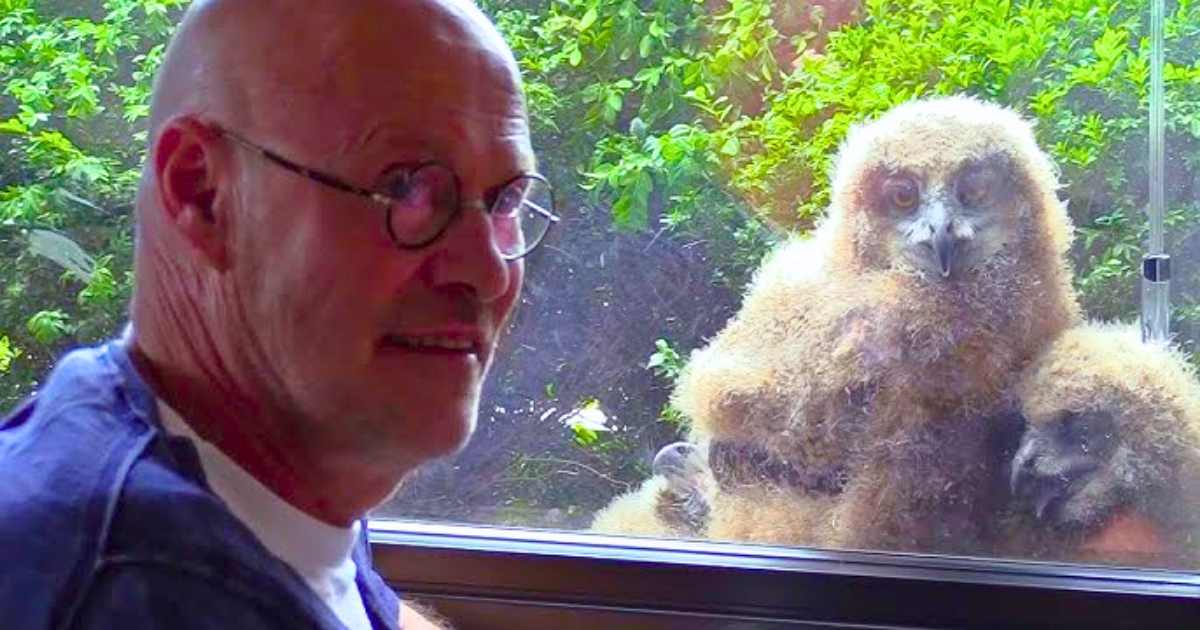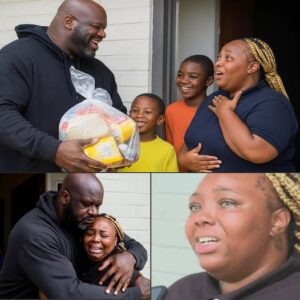Owl encounters don’t get more surprising than this: when a Belgian man named Jos Baart looked out his apartment window one morning, he didn’t just see birds—he saw the world’s largest owl raising a family right outside his glass. This remarkable story highlights how wildlife, nature, and even rescue can come together in unexpected, heartwarming ways.
A Surprising Start: When Animals Choose Your Home
Animals have always fascinated people, but rarely do you get to witness nature’s drama play out inches from your own home. Baart, who lives in a high-rise building in Belgium, first noticed some rustling and unusual noises in his outdoor planter box. Like most of us, he assumed it was a pigeon or maybe a common bird nesting.

But as days went by, he realized the truth was much more exciting: it was a family of owls—not just any birds, but Eurasian eagle owls, the largest species of owl in the world. With wingspans stretching over 1.5 meters (almost five feet), these majestic animals are kings of the European wildlife scene. Usually, they nest on cliffs, rocky ledges, or even abandoned eagle nests, but for some reason, this mother owl chose Baart’s windowsill for her new home.
Nature at Your Doorstep: Watching Wildlife Grow
For Jos Baart, what started as a minor curiosity turned into a full-blown wildlife documentary. He watched as the mother owl fiercely protected her three chicks, feeding them and keeping them warm. At first, Baart admits he found the noise a bit irritating, but soon, he realized he was witnessing something special—a rare glimpse into the secret world of nature that most people only see on TV.
The chicks were endlessly curious, often peeking into Baart’s living room. Sometimes, all three would line up at the window and watch whatever was on television. It became a running joke among Baart’s friends—were the owls becoming TV fans, or were they just fascinated by the lights and sounds from inside?

If you’ve ever wondered what animals think of human entertainment, these owls might have an answer. Maybe they’re into action movies, or maybe they just enjoy the company. Either way, the sight of these fluffy, wide-eyed birds staring at a screen is something Baart will never forget.
The World’s Largest Owls: Facts and Wonders
Eurasian eagle owls (Bubo bubo) are true giants in the bird world. Recognized by the Guinness Book of World Records as the largest owls on Earth, they can weigh up to 4 kilograms and live over 20 years in the wild—sometimes even reaching 60 years in captivity. They are powerful predators, feeding mostly on mammals, birds, and sometimes even other raptors.
It’s rare to see them so close to humans, which makes this story even more special. These owls are normally shy and elusive, blending into their forest or rocky surroundings. For a family to nest right in the heart of a city—and on a busy apartment complex—shows how adaptable wildlife can be.
But as with many animals, their future isn’t always certain. Habitat loss, pollution, and the shrinking of wild spaces have put pressure on owl populations across Europe. That’s why every close-up encounter is a reminder of how important it is to support wildlife rescue and conservation efforts. We need these amazing animals, and they need us to protect the wild places they call home.
When Humans and Nature Meet
Baart’s story isn’t just about cute animals on a windowsill. It’s about the deep connection between people and nature—a connection that’s easy to forget in our busy, modern world. By sharing his experience online, Baart has inspired thousands to pay more attention to the wildlife all around them.
After all, you never know when nature might show up at your window. And when it does, it pays to slow down and appreciate it. Wildlife has a way of reminding us that we’re not the only ones living in our cities; animals, big and small, are our neighbors too.

Why Wildlife Rescue Matters
Stories like this are a reminder of why wildlife rescue and rehabilitation are so crucial. While Baart’s owl family didn’t need direct rescue, countless other animals in urban environments do. Injured birds, orphaned chicks, and other displaced wildlife rely on humans to give them a second chance.
If you’re inspired by this story, you might want to check out these powerful examples of transformation and perseverance in the face of adversity:
Full Story: Man loses 360 pounds naturally, internet rallies to support his next step
Or dive into a different kind of social buzz: Tammy Hembrow’s bikini photos are stirring controversy—here’s why everyone’s talking
Lessons From the Owls: Coexistence Is Possible
The story of Jos Baart and his owl family is more than just a feel-good headline. It shows us that animals can thrive even in unexpected places, and that nature still has surprises for us—if we’re willing to look.
Whether you’re a city dweller or a country explorer, there’s wildlife all around waiting to be noticed and protected. Sometimes, all it takes is a quiet morning, a bit of curiosity, and an open window.
Remember, animals don’t need us to interfere—just to care. Supporting wildlife rescue groups, respecting animal habitats, and sharing stories like Baart’s helps spread awareness and appreciation for the natural world.
For more inspiring stories about transformation, beauty, and the secret lives of both animals and people, check out:
Full Story: Science confirms Kelly Brook’s perfect body, but the real message is bigger than beauty
And don’t miss: The hidden meaning behind Princess Diana’s Cannes gown—a heartfelt farewell to Grace Kelly
Final Thoughts: Celebrating Nature’s Unexpected Guests
If you ever find yourself annoyed by a noise outside your window, take a closer look. Maybe it’s just the start of your own animal adventure. As Baart and his TV-loving owls prove, sometimes wildlife is only a pane of glass away.
By embracing our natural neighbors, supporting rescue efforts, and sharing these moments, we make the world a little friendlier for animals—and for ourselves.


